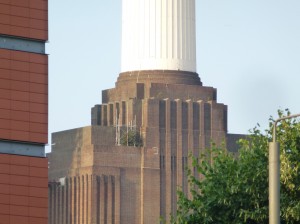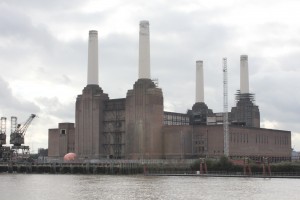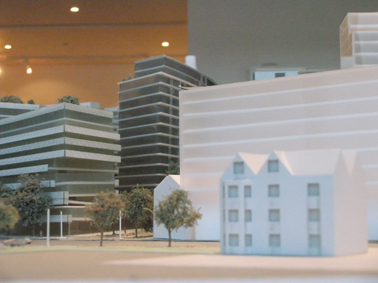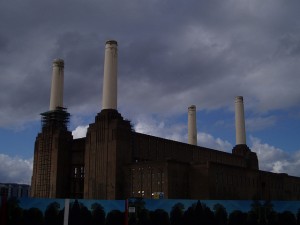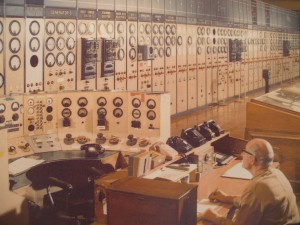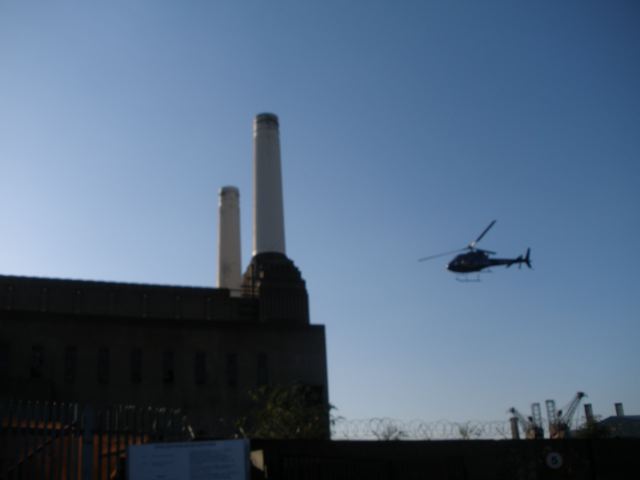Architect Keith Garner is voicing strenuous objections to the so-called ‘regeneration opportunity’ at Nine Elms in Battersea. Wandsworth council and developer St James are proposing the construction of tower blocks of 16,000 new homes, along with shops, offices and a tube extension. He went to see an interactive model of the area, along with videos and other visual displays at the exhibition at Battersea Studios, off Silverthorne Road.
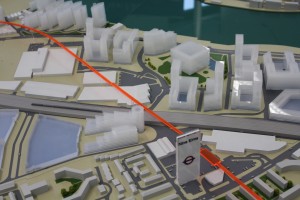
Model of proposed Nine Elms development
Garner, who is also a member of the Battersea Power Station Community Group, is objecting to what he views as a “deeply unattractive project,” on three grounds: the destruction of views, especially of Westminster Palace, the disappearance of promised open green spaces and thirdly, the nonsensical positioning of the new northern line extension from Kennington.
To allow a battery of tower blocks to be built at the east of the area towards Vauxhall would ruin the ordinary public’s views upstream from Waterloo and Westminster and downstream from Battersea and Chelsea, points out Garner, apart from residents and tenants of the new development. Millbank Tower, now a Grade II listed building, was consciously designed to replicate the proportions of Victoria Tower nearby. However, its presence should not be used merely to justify yet another “collection of banal residential and office towers,” which are likely to spoil the backdrop of the Palace of Westminster looking down Whitehall.

Model shows planned cluster of new tower blocks
The architect also noted that the linear park ‘green swathe’ that was such a redeeming feature and justification for the project had vanished from the model! He said it was clear from speaking to Wandsworth Borough Council (WBC) staff at the exhibition that the developers were just ignoring the requirement to have a large green open space and that they had no real power to make them provide it. “Shouldn’t the areas designated as green swathe have been compulsorily purchased or handed over by the developers to WBC?” he remonstrated.
In addition, there was a missed opportunity to move Nine Elms Lane back from the river to the approximate line of the lamented green swathe, as the narrow sites between Nine Elms Lane and the river are so pinched and uncomfortable. This would enable larger sites adjacent to the river and the possibility of more substantial riverside public space than the customary 10 metre wide riverside walk. Moving the road may or may not be a good idea, but could at least have been been investigated. Bigger blocks should be up towards Wandsworth Road, not right by the river.
Finally, the proposed Northern Line extension from Kennington seemed to be purely to serve these development sites, and was not integrated properly at all with east Battersea. “Why, for instance, does the terminus at Battersea Power Station stop about 200 metres short of Battersea Park station? Why, indeed, are there no plans to refurbish the listed Battersea Park Station?” enquires Garner. “There is no public benefit to the existing communities of east Battersea from having the Northern Line, yet almost all the S106 money will go to pay for it rather than real benefits such as upgrading Battersea Park and Queenstown Road stations from their current squalid state, or other real public benefits such as new public park on the river or a 50 metre swimming pool.”
Garner concludes: “The overall impression the exhibition gave me was that this was just another developers’ carve-up like the Guinness site and the riverbank from Wandsworth to Battersea in general, with very little public benefit and a great deal of harm. If this ‘unrivalled opportunity for businesses’ means doing so much damage in an area beside the river and close to the city centre, then the council needs to re-examine its priorities. I would prefer these sites to be left fallow until more civilised and intelligent proposals come forward.”
Click Battersea Power Station for more blogs
See our Battersea Power Station project pages for more information and videos.
Or visit PlanA our general blog on urbanism, planning and architecture.
Spectacle homepage
Befriend Spectacle.Docs on Facebook
Follow SpectacleMedia on Twitter



